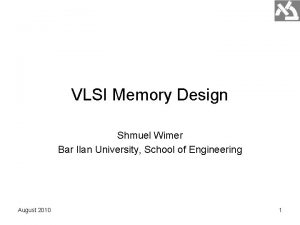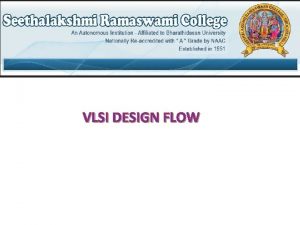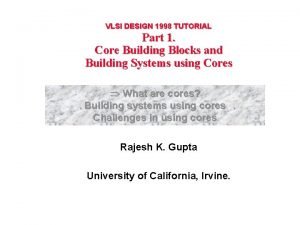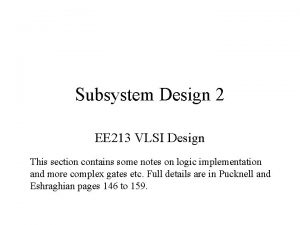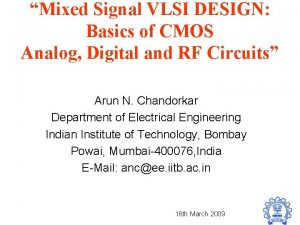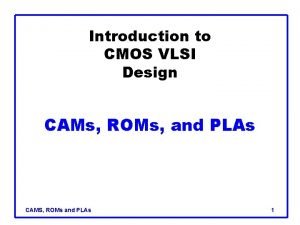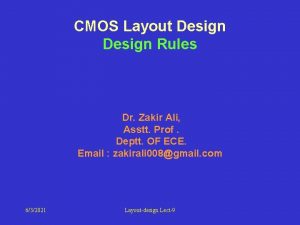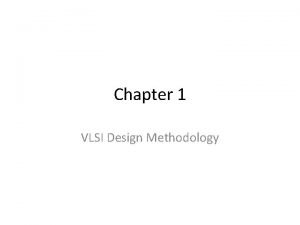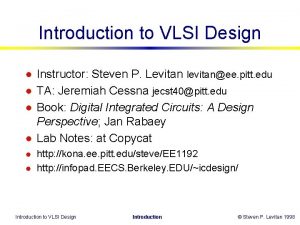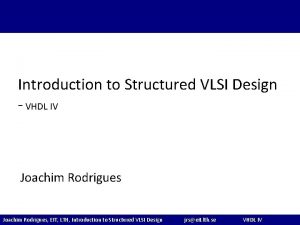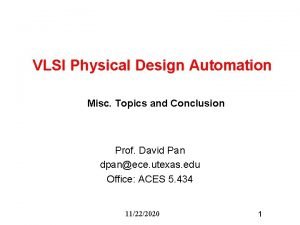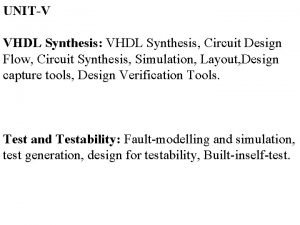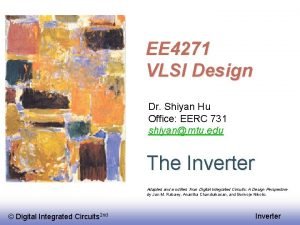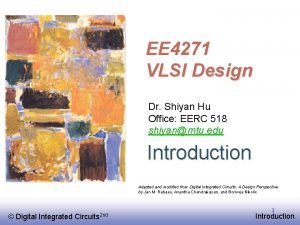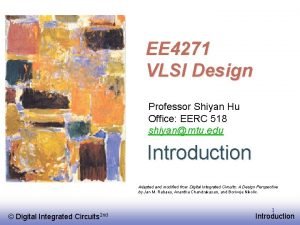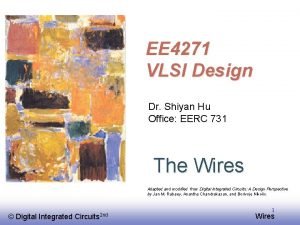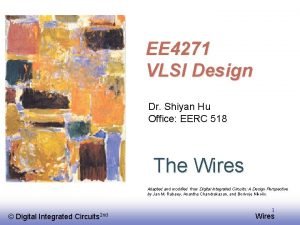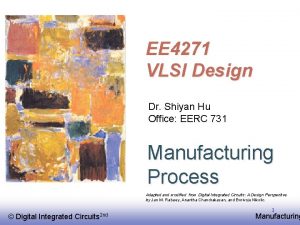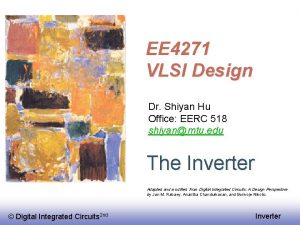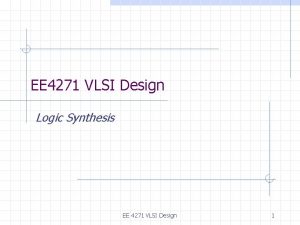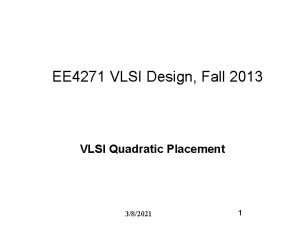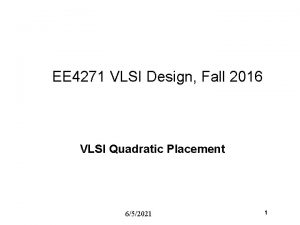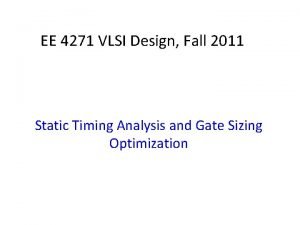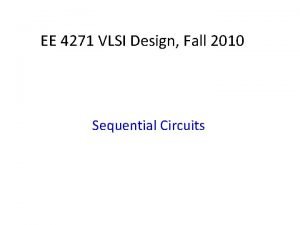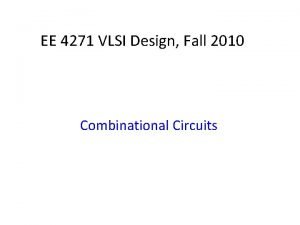EE 4271 VLSI Design Dr Shiyan Hu Office

















- Slides: 17

EE 4271 VLSI Design Dr. Shiyan Hu Office: EERC 731 Manufacturing Process -II Adapted and modified from Digital Integrated Circuits: A Design Perspective by Jan M. Rabaey, Anantha Chandrakasan, and Borivoje Nikolic. © EE 141 Digital Integrated Circuits 2 nd 1 Manufacturing

Challenge Illumination source Mask 193 nm 45 nm Objective Lens Aperture Wafer © EE 141 Digital Integrated Circuits 2 nd 2 Manufacturing

Mask v. s. Printing Layout 0. 13µ © EE 141 Digital Integrated Circuits 2 nd 0. 25µ What you design is NOT what you 90 -nm get! 0. 18µ 65 -nm 3 Manufacturing

Motivation q Chip design cannot be fabricated § Gap – Lithography technology: 193 nm wavelength – VLSI technology: 45 nm features § Lithography induced variations – Impact on timing and power l Even for 180 nm technology, variations up to 20 x in leakage power and 30% in frequency were reported. Technology node 130 nm 90 nm Gate length (nm) Tolerable variation (nm) 90 5. 3 53 3. 75 35 2. 5 28 2 Wavelength (nm) 248 193 193 © EE 141 Digital Integrated Circuits 2 nd 65 nm 4 Manufacturing

Gap: Lithography Tech. v. s. VLSI Tech. 28 nm, tolerable distortion: 2 nm 193 nm Increasing gap Printability problem (and thus variations) more severe! © EE 141 Digital Integrated Circuits 2 nd 5 Manufacturing

Design Rules © EE 141 Digital Integrated Circuits 2 nd 6 Manufacturing

Design Rules Interface between designer and process engineer q Guidelines for constructing process masks q Unit dimension: Minimum line width § scalable design rules: lambda parameter § absolute dimensions (micron rules) q © EE 141 Digital Integrated Circuits 2 nd 7 Manufacturing

Lambda Rule q q Every distance in layout rules is specified by lambda Given a process, lambda is set to a specific value. § Process technology is defined using minimum line width. 0. 25 um technology means minimum line width is 0. 25 um. Lambda=minimum line width/2. § For a 0. 25 um process, lambda=0. 125 um In practice, scaling is often not linear. Industry usually uses micron rule and lambda rule is used only for prediction/estimation of the impact of technology scaling to a design. © EE 141 Digital Integrated Circuits 2 nd 8 Manufacturing

Layers in 0. 25 mm CMOS process Transistor channel © EE 141 Digital Integrated Circuits 2 nd 9 Manufacturing

Intra-Layer Design Rules 4 Metal 2 3 Rules are used to mitigate fabrication error © EE 141 Digital Integrated Circuits 2 nd 10 Manufacturing

Transistor Layout Active Poly © EE 141 Digital Integrated Circuits 2 nd 11 Manufacturing

Layout Editor © EE 141 Digital Integrated Circuits 2 nd 12 Manufacturing

Design Rule Checker poly_not_fet to all_diff minimum spacing = 0. 14 um. © EE 141 Digital Integrated Circuits 2 nd 13 Manufacturing

Some Packages © EE 141 Digital Integrated Circuits 2 nd 14 Manufacturing

Wire Bonding (not printed) Bond wire © EE 141 Digital Integrated Circuits 2 nd 15 Manufacturing

Imprinted Tape-Automated Bonding Disadvantage: Must place I/O pins at the specific locations (i. e. , around the boundary on the die). © EE 141 Digital Integrated Circuits 2 nd 16 Manufacturing

Flip-Chip Bonding q Flip-Chip places connection across the chip rather than around boundary. q The bond wire is replaced with solder bump balls directly placed on the die surface q Chip is flipped upside down q Carefully align to package q Heat to melt solder bump balls © EE 141 Digital Integrated Circuits 2 nd 17 Manufacturing
 Ic 4271
Ic 4271 Shiyan 3
Shiyan 3 Memory design in vlsi
Memory design in vlsi Vlsi design flow y chart
Vlsi design flow y chart Biucache
Biucache Subsystem design in vlsi notes
Subsystem design in vlsi notes Mixed signal vlsi design
Mixed signal vlsi design Vlsi
Vlsi Intro to vlsi
Intro to vlsi Y chart vlsi
Y chart vlsi Cmos design rules
Cmos design rules Modularity in vlsi
Modularity in vlsi Ad hoc testable design techniques
Ad hoc testable design techniques Introduction to vlsi
Introduction to vlsi Structured vlsi design
Structured vlsi design Vlsi conclusion
Vlsi conclusion Vlsi design styles
Vlsi design styles Design flow
Design flow


